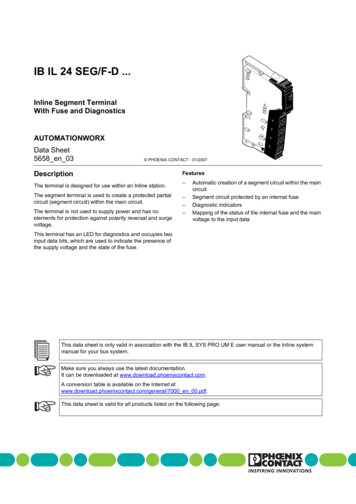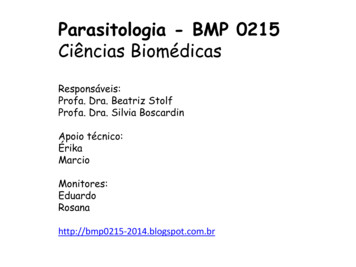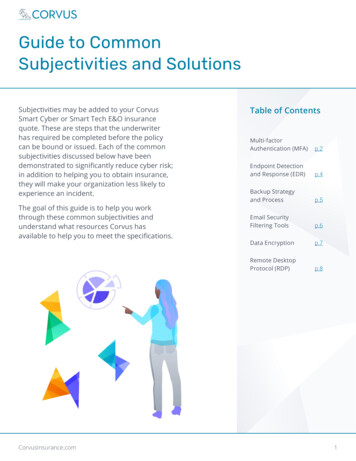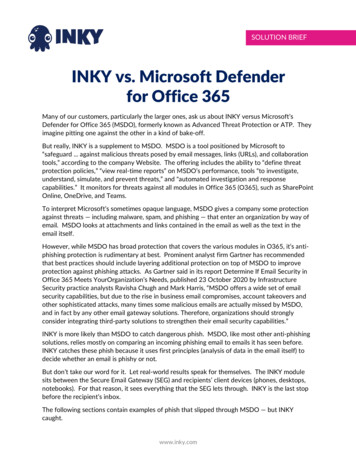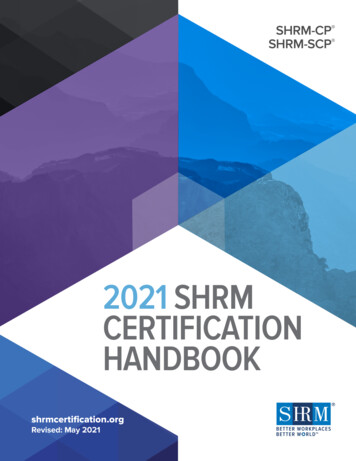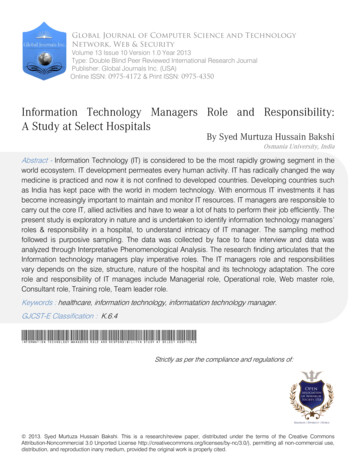
Transcription
The Role of Critical ControlPoints in ControllingContaminants
Hazard Analysis and Critical Control Points(HACCP) Systematic preventative approach to Food Safety.Common with TQM – focuses on process barriersrather than end of pipe quality.FDA/USDA mandatory for juice and meat.Applied to drinking water treatment.A number of examples for IPR and other recycledwater productionConceived in 1960s by Pillsbury for NASADefined in ISO 22000 – Food SafetyRole of Critical Control Points2
The 7 HACCP Principles1Conduct a HazardAnalysis2Determine CriticalControl Points563Establish CriticalLimits4Establish System toMonitor the Control of a7CCPRole of Critical Control PointsEstablish Corrective Action to beTaken When Monitoring a CCP isNot Under ControlEstablish Procedures forVerification to Confirm thatHACCP System is workingeffectivelyEstablish DocumentationConcerning All Procedures andRecords Appropriate to ThesePrinciples and Their Application3
HACCP Approach Applied to rdousContaminantsCritical Control PointsIdentifyHazardousEventsCritical Control PointsIdentify CriticalControl PointsIdentifyHazardousEventsIdentify CriticalValidation ValidationControl PointsDetermine andRank RisksProcedures &CorrectiveActionsProcedures&Corrective resProceduresDetermine andRank RisksIdentifySource ofIdentifySourceContaminantsofIdentify WaterQuality TestingContaminantsIdentify WaterQuality TestingVerificationVerificationOngoingAnalysis andAssessmentOngoingAnalysis andAssessmentMonitoringHazard AnalysisHazard AnalysisMonitoringRole of Critical Control Points4
Select Critical Control Points – Control HazardsClear methodology forCritical Control PointSelectionHalliwell et al WRRF 09-03Role of Critical Control Points5
CCP 5Chlorine DoseExampleCCP 1 – Western Corridor Recycled Water Plant(CT)CCP 4Activated Sludge Process(On Line Ammonia)CCP 2Advanced Oxidation(Peroxide Dose and UV Dose)Microfiltration(Pressure Decay Integrity Test)CCP 3Reverse Osmosis(Permeate conductivity)Role of Critical Control Points6
Establish Critical LimitsThe HACCP team establishes critical limits to assess whether aparticular control measure is effective.If this critical limit is exceeded or not met, it triggers the need for acorrective action.The critical limit can be either a numerical limit (e.g., chlorine residualconcentration, system pressure) or a yes/no type response on whethera particular control measure was completed .Example limit – Western Corridor Qld AustraliaRole of Critical Control Points7
Operational ResponseRole of Critical Control Points8
Where have Critical Control Points BeenUsed Western Corridor Recycled Water Project, Brisbane Australia (ISO 22000Certified). PUB, Singapore SS 444:998 (Singapore Standard) Orange County Water District – Groundwater Replenishment Scheme, CA Melbourne Water – Recycling System Gold Coast Seawater Desalination Plant Elements in the US, but current concern is additional requirements.Role of Critical Control Points9
WRRF-13-03:Can We Trust theTechnology?Critical Control Point Assessment toQuantify Robustness and Reliability ofMultiple Treatment Barriers of a DPRSchemeRole of Critical Control Points10
Direct Potable Reuse - The le of Critical Control Points11
DPR- Raising the StakesConvincing a skeptical publicConvincing regulatorsCan We Trust theTechnology?WRRF 13-03Can We TrustOperations?Trust but VerifyCritical Control Point Assessment to Quantify Robustnessand Reliability of Multiple Treatment Barriers of a DPRSchemeRole of Critical Control PointsWRRF 13-13Development of Operation and Maintenance Planand Training and Certification Framework forDirect Potable Reuse (DPR) Systems12
Utility and Other PartnersWater CampusRole of Critical Control Points13
Goals for 13-03Conduct a hazard assessment to identify health risks, identifywater quality objectives and identify critical control points for 2treatment trains.Full Advanced Treatment(FAT)Non MembraneTreatmentRole of Critical Control Points14
FAT - MF/UF – RO – UV/H2O2 – Cl2 – Engineered StorageRole of Critical Control Points15
Non FAT - O3 – BAC – GAC – UV – Cl2 – Engineered StorageOZONEBACWASTEWATERTREATMENT PLANTCHLORINEGACUV REACTORCHLORINECONTACTORENGINEEREDSTORAGEDRINKING WATER PLANTOR DISTRIBUTIONRole of Critical Control Points16
Conduct a Hazard Analysis Identify hazards and hazardous events. Assess and quantify those risks. Describe how hazards and hazardous events are to bemanaged and which control measures need to beimplemented.IdentifyHazardousContaminantsSource Water AnalysisIdentifyHazardousEventsDetermine andRank RisksIdentifySource ofContaminantsHazard AnalysisRole of Critical Control Points17
Identify Source Water HazardsBegan with a literature review Source concentrations inliterature.Reviewing data fromparticipating utilities.Role of Critical Control Points18
Determined our Treated Water QualityObjectivesTarget water quality -EPA primary drinking water regulations andincluded California Drinking Water Regulations.Used lower of the two values where applicableFocus on action levels and notification levels.The team agreed not to include secondary standards unless anargument can be made for specific individual constituents.Role of Critical Control Points19
Identify Hazardous EventsAccidentalcontamination of thecatchmentDisease outbreak –high pathogen loadFormation of DBPs inthe process trainHigh rainfall event –bypassed treatmentOverdosing,underdosing orcontamination ofchemicalsRole of Critical Control PointsFailure of biologicalprocessesCatastrophicmembrane integritybreach20
Semi Quantitative Risk AssessmentWe established a model source water basedon CA facilitiesContaminantRisk before treatmentRole of Critical Control PointsRisk post treatment21
CCPs – FAT TrainNDMA ControlMicro-organismsMicro-organismsChemicals of ConcernMicro-organismsMicro-organismsChemicals of ConcernLead/copper leaching indistribution system.Role of Critical Control Points22
Treat as CombinedCCPs – Non FAT TrainCCP and Risk Assessment Highlight Need for Process ModificationMicro-organismsTOCParticle RemovalMicro-organismsTOC, DBP, DBPPrecursorsMicro-organismsMicro-organismsRole of Critical Control Points23
How Reliable are these CCPs?Quantify Reliability with Statistical Analysis1009998979695Role of Critical Control ncy8642FrequencyFrequencyMonte Carlo Simulation from FullScale Operating Data
TOC time seriesRole of Critical Control Points25
TOC lognormal probability plotRole of Critical Control Points26
100999897969594FrequencyRole of Critical Control uencyFrequencyTOC Rejection (%) by RO
Role of Critical Control 706560555010099989796959493FrequencyFrequencyRO rejection (%) by Monte Carlo simulation
Where to From Here.Conduct Bench/Pilot Level Challenge Test Studies Identify gaps following review of full scale plants. Planned full scale plant tests (Scottsdale Water Campus) Additional bench scale for gaps if required.Role of Critical Control Points29
Develop Standard Design Approachesand Response StrategiesAlert limit is exceededCritical limit is exceededCheck analyser as perWI-GWA-WCB-2232.Check SCADA reading isconsistent with analyser reading.Check presence of significant airbubbles in the associatedde-bubbling column.MF plant auto shut downCheck analyser as perWI-GWA-WCB-2232.Check SCADA reading isconsistent with analyser reading.Check presence of significant airbubbles in the associatedde-bubbling column.Alert limit is still exceeded?Check the common header andunit selectable turbidity analyserstrends. Look for failure ofindividual MF units.NOYESPut back online the units that areproducing acceptable filtratequality. Leave others offline.Monitor RO feed turbidityanalysers (1A AIT 2004-1 or1B AIT 1921)YESShut down the MF plant if ROturbidity analyser exceeds 0.2NTU for more than 15 minutesCritical limit is stillexceeded?Notify Plant SupervisorNOManually initiate a PDTPDT and start pressure areacceptable?YESNORefer to CCP 5 / PDTRecordRole of Critical Control Points30
SummaryYESCan We Trust theTechnology?Trust but VerifyCCP – ongoing verification of the technology.Provides a framework to transparently demonstrate how risks are managed.Provides reliability and safety of water quality.Integrates well into operations and is practical.Role of Critical Control Points31
Controlling ContaminantsRecycled WaterContaminants fromPollutionAlgae OutbreaksThe Role of Critical Control Points in Controlling Contaminants32
Role of Critical Control Points 7 Establish Critical Limits The HACCP team establishes critical limits to assess whether a particular control measure is effective. If this critical limit is exceeded or not met, it triggers the need for a corrective action. The critical limit can be either a numerical limit (e.g., chlorine residual


